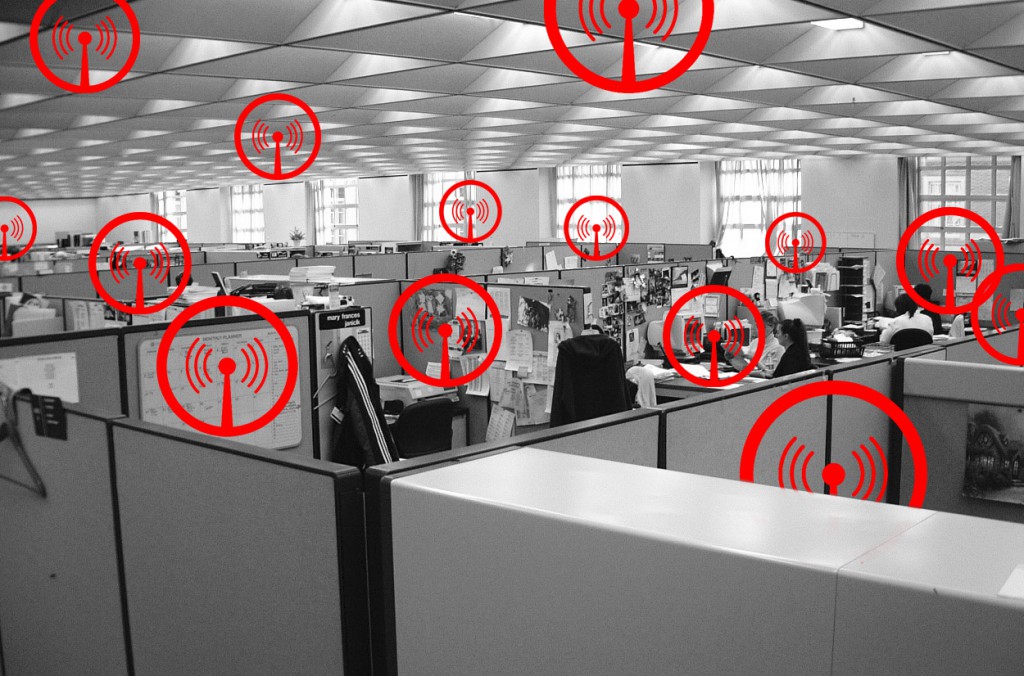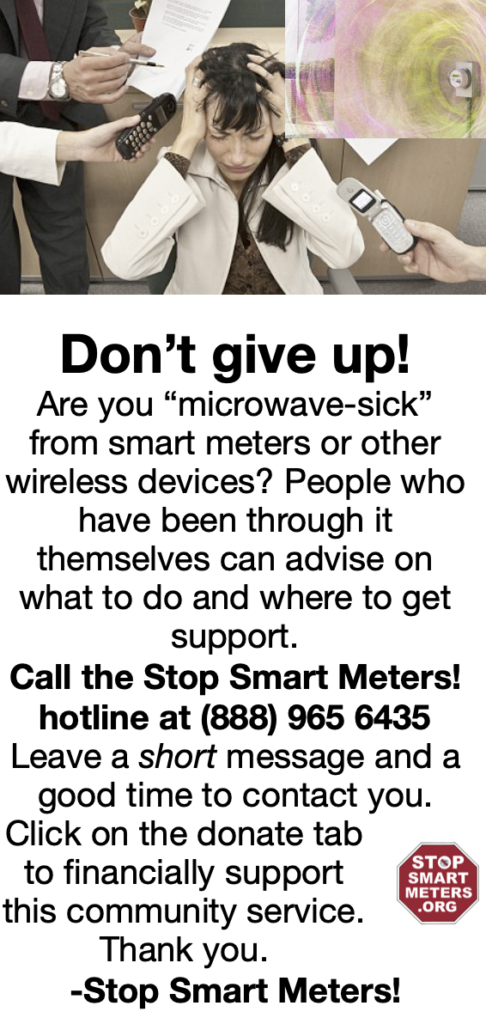 This is part one of series based on interviews with people inside the high-tech industry who’ve become electro-sensitive and begun to question the silence that pervades their field on the matter. To protect their future ability to find work, we’ve used pseudonyms. Click for Part Two, Part Three, Part Four, and Part Five.
This is part one of series based on interviews with people inside the high-tech industry who’ve become electro-sensitive and begun to question the silence that pervades their field on the matter. To protect their future ability to find work, we’ve used pseudonyms. Click for Part Two, Part Three, Part Four, and Part Five.
Located in the Pacific Northwest, ‘Nora Wood’ has worked in high tech for many years, but now finds herself reckoning with the effect her work environment is having on her health and well-being. She sees a lot of good in technology when it’s wisely used. She’s in her mid-forties and has a sharp mind.
It was a six-month period of working at home, between stints doing high-tech office-based work, that brought the problem to the fore. She felt better at home, but then when she started up her current temporary contract with a major tech company, the troubles returned: hair-trigger irritability, sleep problems, and brain-fog. In the office job before the stretch at home, she’d noticed the wifi routers directly over her workspace, but hadn’t put the pieces together.
“I remember thinking, even early on, that it can’t be good to have cell phone repeaters bouncing the signal around inside a shielded office building.” Now she was determined to find out what was causing her problems. She read up online, and got an RF meter, which confirmed that indeed there were high levels around her workspace. One time her Cornet meter topped out with a spike 100 microwatts per square centimeter (µW/cm2), with base levels of 1 to 3 µW/cm2. (Compare to the Bioinitiative Report recommendation of 0.1 µW/cm2 maximum human exposure.) In addition, she became aware of how a nearby cell tower was part of her home environment. She’s done some rearranging and shielding at home, but at work there’s less she can do, working in an open room with others. She has a grounding pad under her desk, which has helped her feel better at work.
Has she broached the subject with coworkers or management? “They’ve seen me using my grounding pad, but I don’t think they want to hear there is anything wrong with their work environment.” She’s tried to explain the way the pad worked in terms of free-radicals and positively charged electrons, “but they still think it’s tin-foil-hat weirdness.”
“They were interested in the RF meter, until I told them the levels I was getting, and they were like, ‘Yeah, but there’s no evidence, no research that’s a problem.’ People in tech are defensive about radio-frequency, because any question about it is going to disrupt their whole world view.”
“If I go full time, I might be able to get my work area configured for some shielding. I don’t think I can work for a huge corporation like Google or Amazon, where I’d have to work on-site every day, all day. But those are the jobs that pay.”
The industry will be squeezing out the older worker faster, as the environment gets saturated with RF, and the denial gets thicker, and more people become ill. “I don’t know how much longer I can do this. My brain isn’t working as well. I feel like I’m doing lesser quality work, and that people perceive me as less smart.” High-tech work is and will be disabling its workers, while the industry refuses to admit the fact.
What will she do in a few months when her contract ends, and she needs another job? She’ll definitely be considering RF exposure when choosing where to work. “I’ll be looking at the set-up, and comparing it to what I already know. I can get creative with questions during the interview, to find out about the wireless coverage in the building without letting them know I’m trying to assess potential exposure. I could also have my meter on inside my handbag, and see what the spikes are, without bringing it out.”
‘Nora’ believes tech has a lot of potential to help people and promote social good, and she cites the example of farmers in Africa texting to get market prices, giving them real bargaining power, rather than relying on the word of deceiving middlemen. “It’s just a shame that there is this horrific other side to it. I’m really conflicted.”
So could technology itself help people address or mitigate exposures? One company, Tawkon (see also this article), has created an app that calculates and displays the likely radiation exposure for the user at any given time, along with a load related features (of course). Apple recently blocked this app for iPhone, though. ‘Nora’ believes open-source Google Android has a better chance of being the venue for radiation-related apps, because there is complete freedom for individual programmers to introduce ideas that could never fly in a top-down corporation like Apple.
“Sharing information is crucial. If you can get a certain number of engineers engaged and understanding the issue, they can create ways to make the technology less detrimental. Like, make it so when your phone rang, it would turn all the other unnecessary stuff off, all the synching, GPS—while it’s near your head.” Once she gets going, there’s a flow of ideas. “You could use the accelerometer inside the phone to sense speed, and shut off automatic connections when you are moving over a certain speed, like in a car,”—that’s when radiation levels from the phone go up. There could be great scope for creativity—once the industry silence has cracked open.
For ‘Nora’ this is a wide-open field full of interesting problems to be solved. She’s a software engineer at heart, and the only difference between her and her co-workers, is that she knows firsthand that this is a problem to work on. But unfortunately, even a load of engineers working wisely to mitigate personal exposure from phones will not address the issue of the ambient, whole-body, 24/7 radio-frequency most of us are exposed to. Indeed, it was the work environment, not personal phone use, that made ‘Nora’ ill.
We hope she can stay in the game long enough to use her brains and her experience to help educate others and eliminate some of the frivolous exposure that people get, simply because nearly the whole industry is in deep and total denial.
It’s clear that if ‘smart’ meter engineers had also been addressing the problem of reducing human exposure to RF, they could have designed a very different device, one that accounted for human health and well-being, not merely corporate convenience and profit.









FROM: http://sagereports.com/smart-meter-rf/?page_id=212
This is a very important, comprehensive report. I encourage you to read it, or at lease the part which interest you. It’s a long report. Here’s an excerpt (RF = Radio Frequency) :
“… In summary, no positive assertion of safety can be made by the FCC, nor relied upon by the CPUC, with respect to pulsed RF when exposures are chronic and occur in the general population. Indiscriminate exposure to environmentally ubiquitous pulsed RF from the rollout of millions of new RF sources (smart meters) will mean far greater general population exposures, and potential health consequences.
Uncertainties about the existing RF environment (how much RF exposure already exists), what kind of interior reflective environments exist (reflection factor), how interior space is utilized near walls), and other characteristics of residents (age, medical condition, medical implants, relative health, reliance on critical care equipment that may be subject to electronic interference, etc) and unrestrained access to areas of property where meter is located all argue for caution.
Electronic Interference
Consumers may experience electronic interference (electromagnetic interference or EMI) from smart meter wireless signals. The FCC also is charged with investigating consumer complaints about electronic interference.
“The FCC requires that unlicensed low-power RF devices must not create interference and users of such equipment must resolve any interference problems or cease operation. According to the FCC (47CFR Part 15): “The operator of a radio frequency device shall be required to cease operating the device upon notification by a Commission representative that the device is causing harmful interference. Operation shall not resume until the condition causing the harmful interference has been corrected.”
(EPRI, 2010)
Medical and other critical care equipment in the home environment may not work, or work properly due to electronic interference from smart meters.
Security systems, surveillance monitors and wireless intercoms may be rendered inoperable or unreliable. Some cordless telephones do not work reliably, or have substantial interference from smart meter RF emissions.
Electronic equipment and electrical appliances may be damaged or have to be replaced with other, newer equipment in order not to be subject to electromagnetic interference from smart meter RF bursts.
Americans With Disabilities Act
People who have medical implants, particularly metal implants, may be more sensitive to spurious RF exposures for two reasons. Electromagnetic interference (EMI) with critical care medical equipment and medical implants is a potentially serious threat. Patients with deep-brain stimulators (Parkinson’s disease patients) have reported adverse health effects due to RF from various environmental sources like security gates and RFID scanners. Patients with deep brain stimulators have reported the devices to be reprogramming or electrodes shut-down as a result of encounters with wireless RFID scanners. One manufacturer, Medtronics, has issued a warning for DBS implant patients to limit RF exposure to less than 0.1 W/Kg SAR (or sixteen times lower than for the general public) for MRI exposures.
The IEEE SC4 committee (2001) considered changes to existing ANSI/IEEE standards adopted in 1992 (C95.1-1992). They discussed vulnerable organs (eyes, testes) and metallic implants that can intensify localized RF exposures within the body and its tissues.
“Question 20: Are there specific tissues or points within the body that have particularly high susceptibilities to local heating due to thermal properties in the immediate vicinity of the tissue?”
Committee minutes include the following discussion on metallic implants.
“Metallic implants are an interesting example of this question. There can be very localized high field concentrations around the tips of long metal structures, in the gaps of wire loops. Of course, these metal devices don’t create energy, but can only redistribute it, so the effect is limited to some extent. Also the high thermal conductivity and specific heat capacity make them good thermal sinks for any localized heat sources generated around them.”
Since deep brain stimulators in Parkinson’s patients involve metal implants that are essentially long metal structures with tips that interface with brain tissue and nerves within the brain and body, exposing such patients with implants to high levels of pulsed RF that can produce localized, high RF within the body is certainly inadvisable. It is clear the IEEE SC4 committee recognized the potential risk by to calling such implanted metallic devices good ‘thermal sinks’ for localized heating dissipation.
The FCC’s Grants of Authorization and other certification procedures do not ensure adequate safety to safeguard people under Department of Justice protection under the Americans with Disabilities Act.”
______________
Please everyone: LOCK UP YOUR ANALOG METERS. This is the most effective way to keep the Evil Empire out of our homes.
What about tiny metal stints placed in clogged heart arteries to open them up? Wouldn’t the rf bounce off it and increase exposure in the heart and chest of the person, possibly disrupting normal patterns of an already challenged or damaged heart?
One more question, Have there been many reports of interference with medical implants from cell phones, wifi or smart meters??? Why isn’t the media reporting this? Or is that obviously due to a black-out on anything negative about wireless technologies???
(thanks for this great series)
The story of Per Segerbäck is worth reading:
http://www.scribd.com/doc/33983803/PopSci2010-03-Disconnected-Per-Segerback , page 42-51
It is also good to understand how the employer responded to this problem:
http://www.electroallergie.org/Openingspagina/Engelse%20samenvattingen/per%20segerback.pdf
http://www.feb.se/emfguru/Ehs/ehs-victim.html
Other cases:
http://www.environmentalhealth.ca/w97primer.html
Thank you for bringing up this important topic. I personally know (and help) several EHS people in high-tech companies. People are so afraid of A) loosing their job B) talking about EHS in a culture that does not admit its existence.
Take care
Mikko
YES! “hair-trigger irritability, sleep problems, and brain-fog” are some of the most common first symptoms, but very few ever make the connection with their cordless phones, WiFi, mobile masts, work-place, etc., etc. But it IS best to catch it early and reduce exposure early, while you still still cope with modern life to some degree (rather than wait until it hits crisis point)
What I HAVE found is that IF you can create an electrosmog/pulsed-microwave free environment at home and to sleep in, your body recovers enormously overnight and makes the next day’s exposure easier to cope with. . For full details of how to identify and deal with ALL the sources I wrote: http://WaveGoodbye.info
And most of all – DON’T ALLOW A SMART METER ON YOUR HOME (preferably NOT nearby either!)
The medical implant issue must be addressed. This seems to be over looked by the “utility industrial complex”. I have read PSC complaints from people with implants. One woman with a deep brain implant says the manufacturer of her device recommends that she NOT have a smart meter. She was told to call the US Dept of Energy, the DOH and the EPA ! The outcome of her plea is unknown. I have contacted Boston Scientific, the maker of my father’s pacemaker. Stay tuned……
Pingback: Sensitive and Inside Big Technology: Views from the Other Side Pt 1 | OzHouse Alt News
Pingback: Sensitive and Inside Big Technology: Views from the Other Side (Part Three) | Stop Smart Meters!
Pingback: Sensitive and Inside Big Technology: Views from the Other Side (Part Two) | Stop Smart Meters!
I just got finished with another comment and they have to be in here too they said that my e mail was incorrect
So here I go agian they are not going to stop m e
I have recived 37 treaments of radiation . They installed the Smart meter on the out side wall of my bedroom I woke up with welts and blister on parts of my body. Good Lord I had to soak in a hot bath with TEA TREE oil and afterwards powdered down with medicated powder
this releived it some but it left brown scares and I am so mad that I have to do someting about this.
I work with harmonic sounding and I am going to gather the thousands of people that are at war with this situation and we are to gather at Doger Stateum and sound our way out of this. Only it will be a peace ralley no protesting they would love that disturbance if they cannot hear our words of fear then they will hear our fearless harmonic sounding.
my e mail is jvlifecoach@netzero.net
lets talk and thank you for all the support we are getting from this website
JOsette Vettel
The gathering will be anounced by tv or meditor
My Mom died momentarily because of an intrusive exam preformed as an attempt to resolve why her pacemaker and heart and body all seemed to be in good working order but she was suffering from dizziness, head ache, sleeplessness, and irritability to name a few.
I discovered after reading the warnings of the pacemaker manufacturer the assault perpetuated by these so called smart meters, I shall refer to as Death Meters.
I demanded that the meter be removed immediately and to my surprise it was; mom noticed an almost immediate improvement in over all health and even noted that her Farmville / computer was working better.
During the somewhat heated discussion with the local utility Death Meter expert, it was brought to my attention that I had not read the utilities defense of the Death Meter.
So I read the utilities defense of the Death Meters, and became even more outraged.
I found what I call “half truths” they fool the gullible masses that live in denial with facts that omit critical portions. Please allow me to explain.
These Death Meters transmit on two different frequencies.
One of them is the data transmission, which sends the utility our person data about our personal life, they immorilly intrusively accumilate. This transmission is generally in the 2.4 GHz band though this differs between Death Meter Mfg. The utility tells the public how they innocently only transmit a couple times a day, it’s for our best interest (“BS”) and the level of danger is insignificant.
The other is that data accumulation RF transmission, oops they must have forgotten about that one. What they don’t tell the public is the Death Meters also transmit on the 900 MHz frequencies (again depending on Mfg). This is the damaging wave as it is sprayed upon us as many as 180,000 times a day 24/7/365. This is the fatal wave that was indirectly responsible for my mother’s momentary death. Yes she died and was revived during the medical exam that was a result of the damage caused by the death meter.
The International Agency for Research on Cancer, in cooperation with the World Health Organization, have determined that these Death Meters are class B2 carcinogen which I understand to be in the same class as DDT.
In conclusion, it is my opinion that these Death Meters are the equivalent of spraying DDT on us 180,000 times a day.
And just for fun, “the tin hat joke” Tin foil is made of aluminum which is a fairly good conductor, so anyone smart enough to want to protect him or herself from harmful RF would want to wear a lead hat. LOL
rl